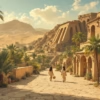# Luxor: A Journey Through Egypt’s Ancient Past
As you step foot into Luxor, you are not merely entering a city; you are embarking on a voyage through time, where the whispers of ancient pharaohs resonate in the air. Known as the world’s greatest open-air museum, Luxor is home to some of the most remarkable monuments and archaeological treasures of ancient Egypt. From the majestic temples to the sacred tombs in the Valley of the Kings, this destination offers an unparalleled glimpse into the civilization that shaped the course of history. In this blog post, we will take you through the many wonders of Luxor, providing invaluable insights for travel agents and tour operators looking to create unforgettable Luxor tours.
## Discovering Luxor: The Beating Heart of Ancient Egypt
Luxor, situated on the east bank of the Nile River, is often referred to as the “city of a hundred gateways.” The name itself pays homage to the countless temples and monuments that stand as testaments to the grandeur of ancient Egyptian civilization. With an expansive array of sites to explore, Luxor attracts millions of tourists each year, making it essential for travel professionals to offer memorable experiences that showcase the region’s rich heritage.
### The Valley of the Kings: A Royal Necropolis
One of the crown jewels of Luxor is undoubtedly the Valley of the Kings. This royal burial ground housed the tombs of Egypt’s most illustrious pharaohs, including Tutankhamun and Ramses II. Visitors can explore the intricately decorated chambers, where hieroglyphs and vibrant frescoes tell the stories of the afterlife and the beliefs that shaped ancient Egyptian culture.
**Question:** *What makes the Valley of the Kings a must-visit on any Luxor tour?*
The Valley of the Kings is essential because it offers an authentic glimpse into the burial practices and beliefs of ancient Egyptians. Each tomb is a unique masterpiece, showcasing the art, architecture, and symbolism of the time. The experience of standing before the tomb of Tutankhamun, whose treasures captivated the world, is nothing short of awe-inspiring.
### Karnak Temple: A Testament to Divine Architecture
Just a short distance from the Valley of the Kings lies the sprawling Karnak Temple Complex, one of the largest religious buildings ever constructed. Dedicated to the Theban triad of Amun, Mut, and Khonsu, Karnak is a marvel of architecture and engineering. Visitors can wander through towering columns, sacred lakes, and vibrant hieroglyphics that narrate the epic tales of gods and kings.
**Question:** *How can tour operators enhance the experience of visiting Karnak Temple for their clients?*
To enhance the Karnak experience, tour operators can offer guided tours that include storytelling elements, allowing visitors to connect with the site’s rich history. Incorporating light and sound shows in the evening can also provide a unique perspective, bringing the temple’s ancient past to life through dramatic reenactments and stunning visuals.
### Luxor Temple: The Heart of the City
Located on the east bank of the Nile, Luxor Temple is another highlight of any Luxor tour. This stunning temple, built to honor the god Amun, exemplifies the grandeur of ancient Egyptian architecture. The towering statues of Ramses II and the magnificent pylon entrance create an imposing yet majestic atmosphere.
**Question:** *What unique experiences can travelers expect when visiting Luxor Temple?*
Travelers can enjoy a leisurely stroll along the Avenue of Sphinxes, which once connected Luxor Temple to Karnak Temple. The temple is beautifully illuminated at night, offering a magical ambiance that captivates the senses. Additionally, the opportunity to witness local cultural performances and traditional music adds depth to the visit, creating a well-rounded experience that combines history with contemporary Egyptian life.
## Travel Tips for a Luxor Adventure
For travel agents and tour operators looking to create the perfect Luxor itinerary, here are some essential tips to consider:
1. **Timing is Everything:** Encourage travelers to visit during the cooler months (October to April) for a more pleasant experience. Early morning or late afternoon visits to major sites can also help avoid the heat and large crowds.
2. **Cultural Sensitivity:** Remind clients of the importance of dressing modestly, especially when visiting religious sites. Comfortable footwear is essential for exploring the vast temple complexes and walking through the Valley of the Kings.
3. **Local Cuisine:** Introduce travelers to the culinary delights of Luxor. Recommend local restaurants that serve traditional Egyptian dishes like koshari, falafel, and fresh seafood. Dining experiences can enrich the journey and provide a taste of authentic Egyptian culture.
## Conclusion: Luxor Awaits
Luxor stands as a testament to the grandeur of ancient Egypt, offering travel professionals a wealth of opportunities to create unforgettable experiences for their clients. With its breathtaking monuments, rich history, and vibrant culture, Luxor is more than just a destination; it is an invitation to explore the wonders of a civilization that has fascinated the world for millennia. By crafting immersive Luxor tours that highlight the Valley of the Kings, Karnak Temple, and Luxor Temple, travel agents and tour operators can provide their clients with a profound connection to the past. As you prepare your next itinerary, remember that in Luxor, every stone has a story, and every visit is a journey through time.





